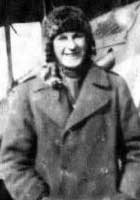William Mayes Fry
| William Mayes Fry | |
|---|---|

William Mayes Fry c.1917
|
|
| Born |
14 November 1896 Twickenham, Middlesex, England |
| Died | 4 August 1992 (aged 95) Greenwich, London, England |
| Allegiance | United Kingdom |
| Service/ |
British Army Royal Air Force |
| Years of service | 1915–1934 1939–1945 |
| Rank | Squadron Leader |
| Unit | |
| Battles/wars | World War I World War II |
| Awards | Military Cross |
Squadron Leader William Mayes Fry MC (14 November 1896 – 4 August 1992) was a World War I Royal Flying Corps and Royal Air Force fighter ace. He was credited with eleven aerial victories, piloting no fewer than four different types of fighter aircraft. Fry also has the distinction of being one of the few World War I airmen to survive to the 1990s.
Fry joined the army and was commissioned as a second lieutenant in the Somerset Light Infantry on 10 June 1915. Later he trained as a pilot, receiving Royal Aero Club Aviator's Certificate No. 3003 after flying a Maurice Farman biplane at the Military Flying School, Birmingham, on 24 May 1916, and on 16 June he was appointed a flying officer in the Royal Flying Corps, and transferred to the General List.
He first served in No. 12 Squadron, then No. 11 Squadron, flying BE.2s during the Battle of the Somme, and being promoted to lieutenant on 31 October 1916.
His "C" Flight was then transferred to No. 60 Squadron, where, flying a Nieuport 17, Fry scored his first win on 2 May 1917; two days later, he shared a victory with Billy Bishop. Further solo victories were gained on 13 and 19 May, and for his fifth, an Albatros D.III was driven down out of control on 16 June, shared with Keith Caldwell. During this time, he also flew Morane-Saulnier Is, and one of his squadron-mates was Albert Ball.
On 16 August 1917 Fry was awarded the Military Cross, his citation reading:
On 1 September 1917 he was appointed a flight commander with the temporary rank of captain, and was transferred to No. 23 Squadron to command "C" Flight. Flying a SPAD VII he gained wins on 20 November and 12 December 1917. He upgraded to a SPAD XIII for his next win, on 4 January 1918. Two days later, he was back in a SPAD VII, hunting in company with Frank Granger Quigley. They jointly shot down and killed Pour le Merite winner Leutnant Walter von Bülow-Bothkamp. Fry would score once more in a SPAD XIII, shooting down in flames an Albatros on 23 January. Fry then transferred to No. 79 Squadron, where he claimed his last victim, using a Sopwith Dolphin to down a Fokker Dr.I on 11 May 1918. For his final tally, besides destroying the two enemy fighters in company with Bishop and Quigley and flaming the Albatros, Mays had destroyed two other enemy aircraft, captured one, and driven down four others.
...
Wikipedia
